
Teacher | Writer | Traveler
Bhutan Adventure with Phyllis: November 4 - 17, 2013

Bhutan flight..."Normal procedure" as we approach Paro to land.

Vickie entertained by monks in Paro Dzong.

Paro Dzong's Bhutanese architecture in the monastic building where monks live.

Paro River and Dzong, with lookout tower above the Dzong, now a museum.
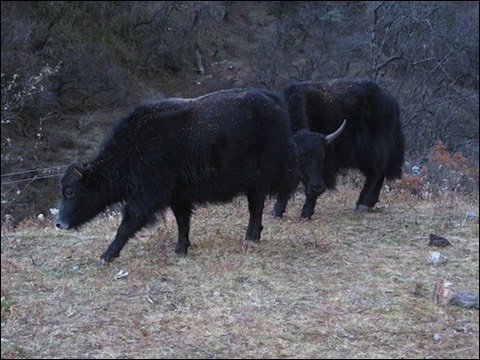
Yaks along the wayside: broad-backed beasts of burden, ideal grazing animals for high altitudes, provide meat and milk.
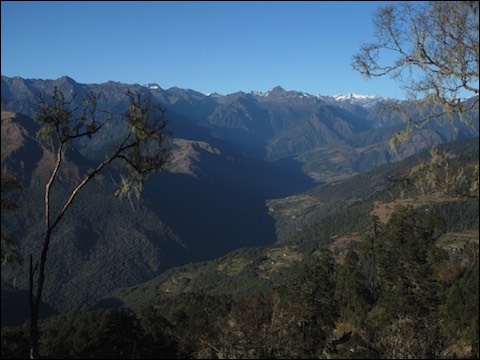
Bhutan's rugged terrain, from Pele La (13,000 ft. pass): steep sided mountains, patches of terraced fields, and small communities and farms.
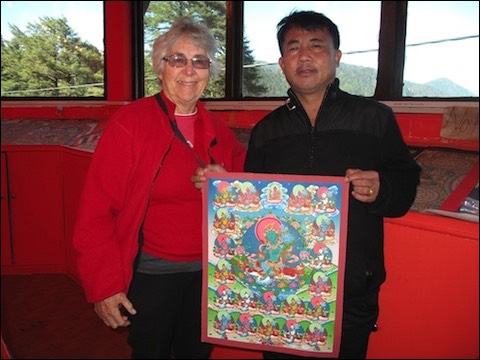
Buying a Green Tara tanka painting from the artist, Dorji, in his art store and art school at Dochu La (pass at 10,000) on our return trip to the capital Thimphu.
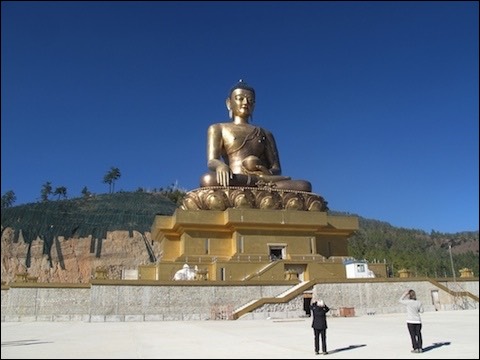
The Golden Buddha, overlooking Thimphu, a massive 159 ft. fall sculpture covered in gold leaf, a gift from a wealthy Buddhist businessman from Singapore.
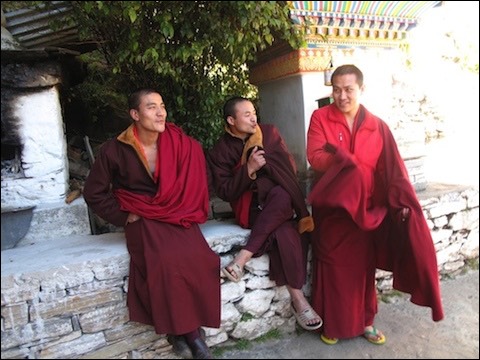
Tango Monastery, Bhutan (10,000 ft). Monks enjoying a joke and conversation between classes. Tango is both a teaching monastery and a school for monks to progress with their studies.
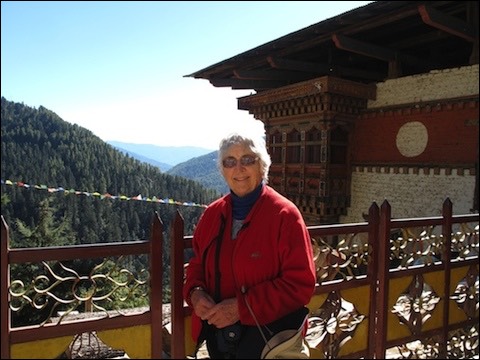
Phyllis enjoying the view from Tango Monastery at 10,000 ft.
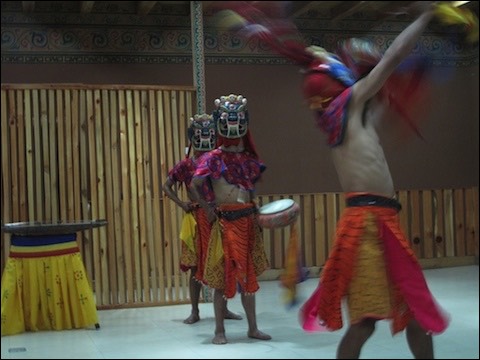
Paro: evening entertainment. Masked dancers performing for us some of the traditional Bhutanese ceremonial dances.
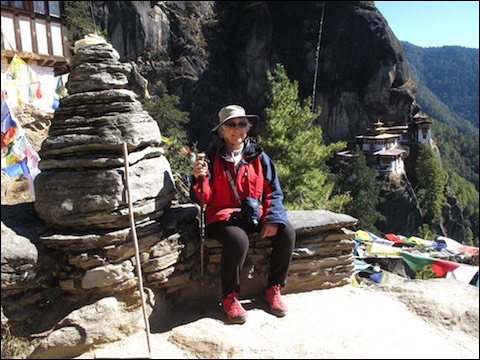
Tiger's Nest Monastery, a Bhutanese gem. Another monastery at 10,000 ft. (I rode up on horseback, however! The rest hiked.) One of the most sacred monasteries in Bhutan, much revered by Bhutanese and Buddhists world-wide, it burned down in the year 2000, and was rebuilt within 4 years with more modern and fireproof materials.
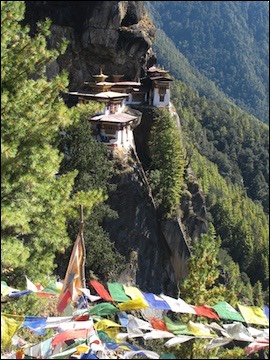
Tiger's Nest Monastery. Built into a mountainside ledge, as if hanging precariously at 10,000 ft.
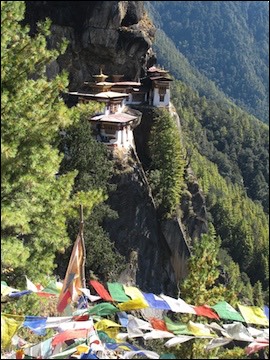
Tiger's Nest Monastery. A working monastery open to the public year round for a fee; free to Bhutanese one day a year as a pilgrimage destination to pray to Guru Rinpoche, who brought Buddhism to Bhutan in the 8th century and who founded this monastery.

Crossing the iron suspension bridge on our way to Thimphu.

Dochu La, a pass at 12,000 ft. with 108 chorines to honor Bhutanese heroes killed in battle.
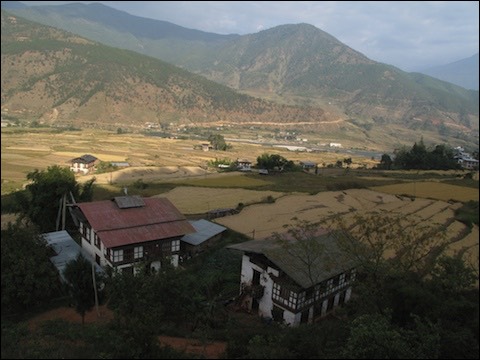
View from Lobesa Hotel in Wangdue Valley.
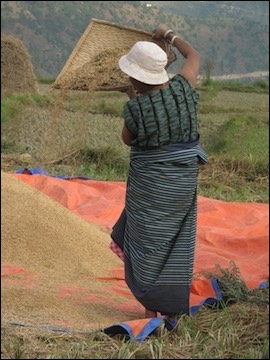
Winnowing rice in Wangdue Valley.
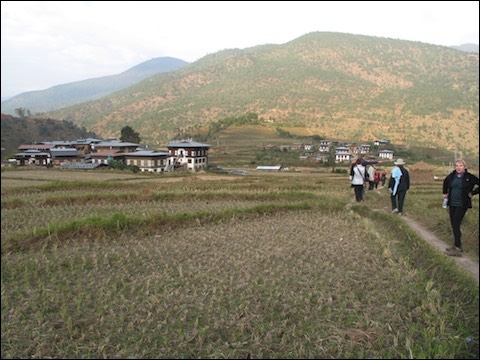
An afternoon through the rice fields.
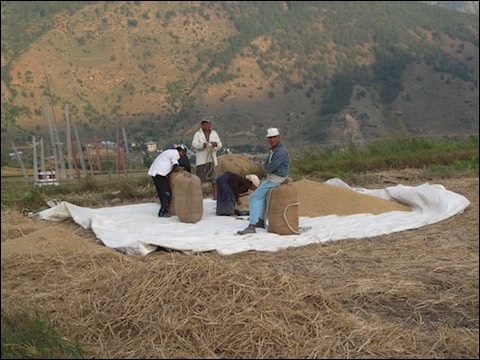
Packing rice in 120 lb. sacks.
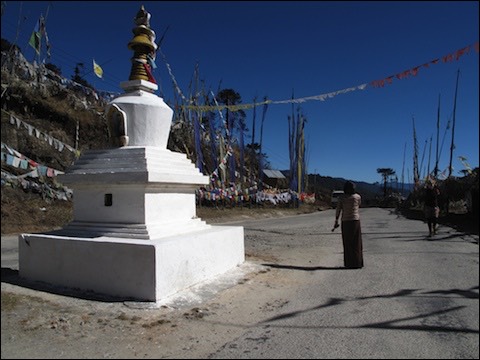
Pele La, another pass at 13,000 ft., decorated with prayer flags and a chorine filled with prayers on our way to Bumthang.
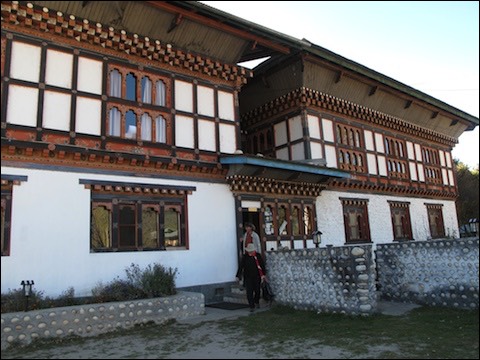
Our hotel in Bumthang.
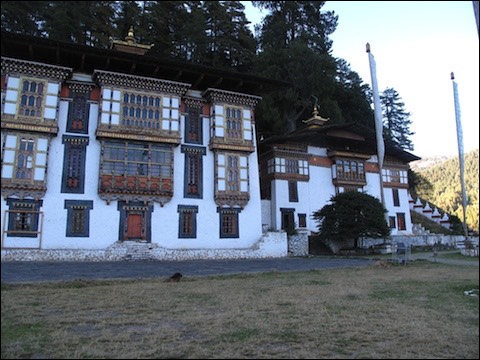
Lakhang Monastery, Bumthang, includes one of the oldest in Bhutan (on rt. of photo).
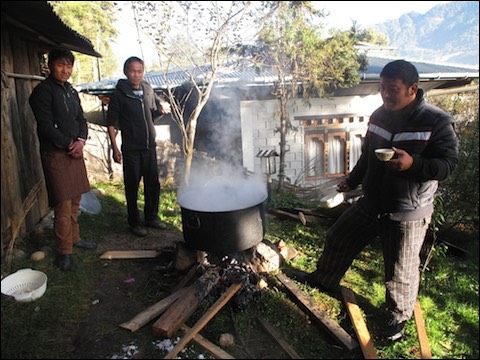
Cooking porridge for pilgrims passing through.
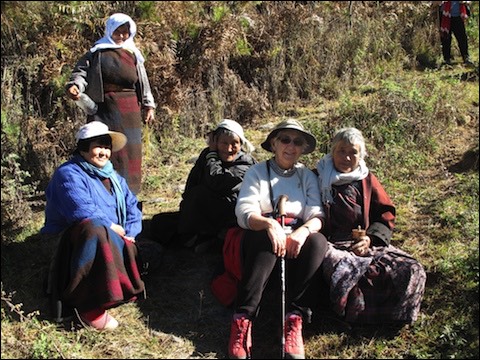
Bhutanese women on pilgrimage in Bumthang.
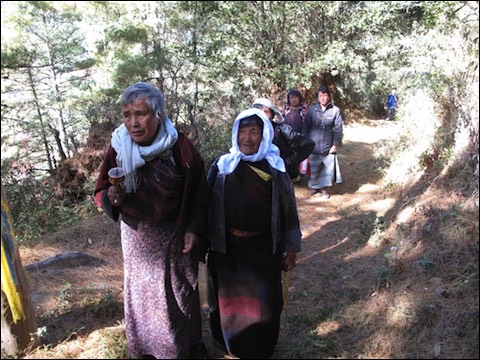
Women continuing their pilgrimage walk.
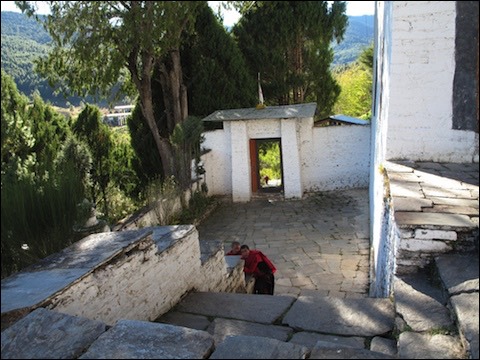
Entrance to Jakar Dzong in Bumthang.
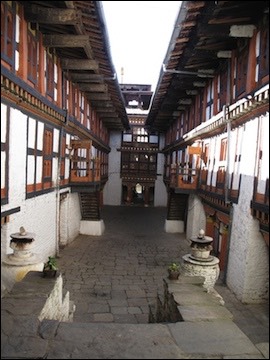
Buildings inside Jakar Dzong.
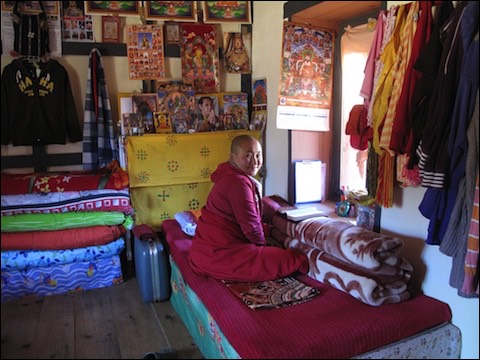
A nun in her bedroom in the nunnery in Tang Valley.
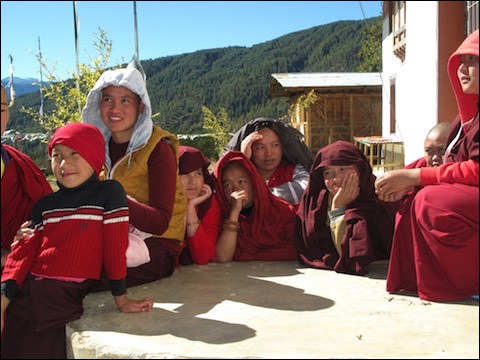
Nuns at a nunnery in Tang Valley.
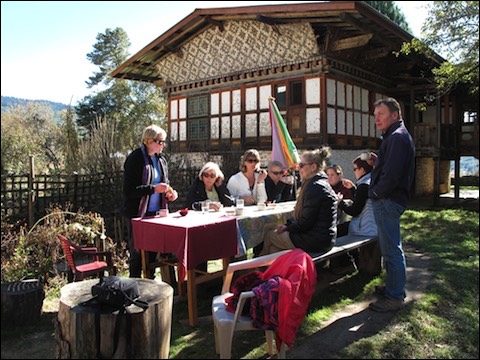
Al fresco refreshments on arrival at the guest house in Tang Valley.
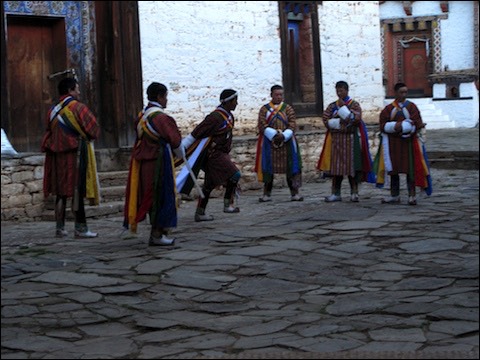
6 am sword dance outside the Palace front door, Tang Valley.
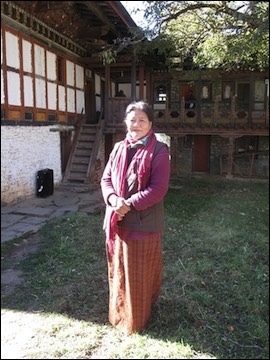
Kunzang Choden outside her guest house.
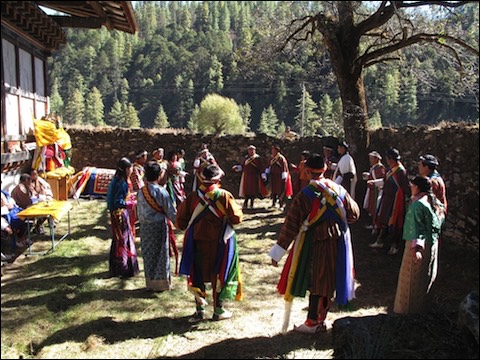
Dancing and singing outside the temple at the Tang Festival.
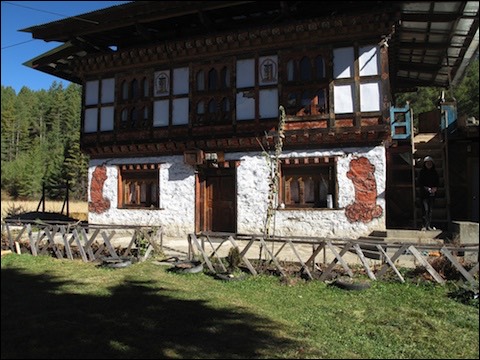
A typical Bhutanese country home.
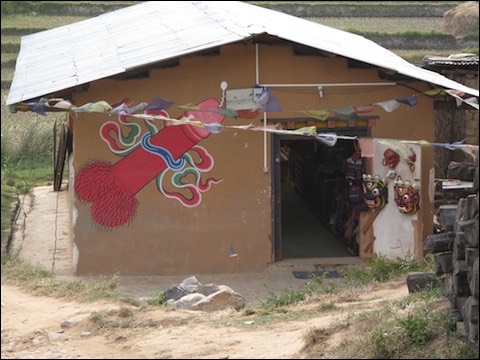
The penis in Bhutan is regarded as a "symbol of protection" often seen on the entrances of shops, restaurants, and homes, ubiquitous across Bhutan.
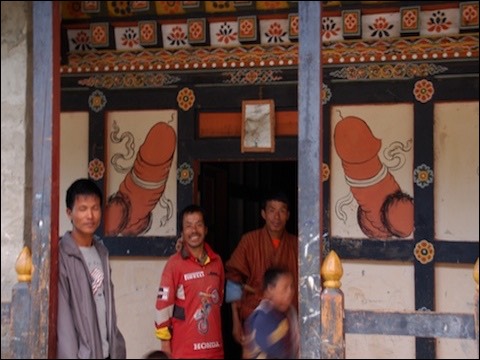
The penis in Bhutan is regarded as a "symbol of protection" often seen on the entrances of shops, restaurants, and homes, ubiquitous across Bhutan.
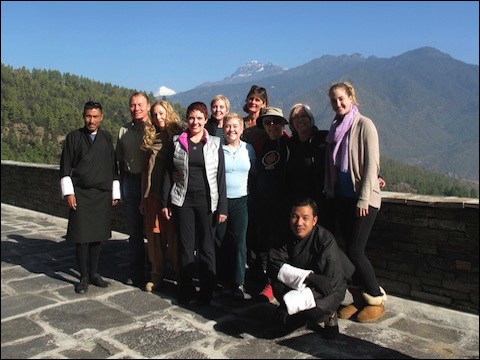
Group with guide, Tenzin, and driver, Thupten, at Nak-Sel Hotel balcony.
...and what an adventure it was in the Land of Gross National Happiness! A group of 8 wonderful people spent 2 weeks together traveling across Bhutan: Ed, Carrie, Vickie, Debbie, Hayley, Elaine, Lyndsay, and Carla joined me on this trip of a lifetime. We met at Druk Airways counter in Bangkok at 4 am to catch the 6 am flight to Paro, Bhutan. We enjoyed Himalayan views with K2 clearly seen to the west just before descending into deep valleys on approach to Paro. The pilot described our descent into Bhutan’s steep sided twisting valleys as “normal procedure” and not to worry as our wing tips seemed to touch the rice fields and forests. Arriving at 8 am we were met by Tenzin, our guide and Thupten our driver from Rainbow Tours and Treks, who whisked us in a comfortable and spacious Toyota minibus to our lovely Boutique Hotel, Nak-Sel, a 1/2-hour drive away, where we were welcomed with our 4th breakfast of the morning, considered an auspicious start to our trip!
Bhutan is a small, very mountainous country between Tibet and India, east of Nepal and Sikkim. Our bus trip on the National Highway took us 3/4 across the country from Paro to Bumthang along very steep roads twisting around deep valleys and over high passes. We visited 4 Dzongs: Paro, Punakha, Trongsa and Jakar, Administrative and Monastic Centers, housing government offices and temples, mostly built in the 16th Century. Visiting each Dzong as well as many monasteries across the country gave us a broad understanding of the history of Bhutan, since each is dedicated to the historic person who paid for its construction. We also had the privilege of attending an evening prayer service in a small monastery in the Phobikha Valley, home of the black neck cranes in winter. We invited the head monk to dine with us in our campsite, beautifully laid out in a large dining tent. He answered all our questions openly about his life and his work with the young monks in this isolated valley. He graciously allowed us to camp in the grounds of the monastery. The monks are self supporting, making incense sticks for export. I do believe we bought him out of incense the next morning! Our group became excellent shoppers throughout our trip.
We stayed 4 days in the Bumthang area, visiting the Jakar Dzong, and joining a group of pilgrims walking to the various sacred sites in the area. The hotel we stayed in cooked a huge cauldron of porridge for any pilgrim needing nourishment. Our main destination was the Tang Valley within the Bumthang district where we stayed a day and night in a very old, and partly renovated “guest house” belonging to the “Palace,” a large medieval building which pitched us back into the middle ages. We did have warm bedding and some of us had a Bukhara or woodstove. We enjoyed a typical Bhutanese dinner of red rice, and meat stew with plentiful root and green vegetables, locally grown. We were very fortunate to meeting the owner, Kunzang Choden, a dynamic and articulate woman telling us her life story growing up in Tang and in the Palace over the past 60 years. The changes in Bhutan from a serf society with large wealthy landowners to a democracy decreed by the 3rd king, educated in Scotland, determined to change his country overnight in the 1950s. It has had its ups and downs over the years as described by Kunzang, with still much to accomplish in improving roads, the economy and education while maintaining their language, religion and culture including their national dress; ghos for men and kiras for women. The Palace is currently a museum showcasing the old ways of life as lived in Bhutan not so long ago.
We all attended the Upper Tang Annual Festival the next day. One of the original and oldest festivals in Bhutan, the starting ritual was a 6 am “wake-up call” at the main Palace door to thank the owner for his care of the people in his domain. The men of the village, draped in colorful ribbons over their traditional gho, danced the sword dance accompanied by leaps and shrill vocal calls. After breakfast, al fresco in beautiful sunshine, we were able to walk to the main festival from the guest house through recently harvested rice fields and working farms to a nearby monastery for the morning ceremonies of more sword dances, women dancing culminating in the famous yak dance, with 3 men in a yak costume dancing and prancing among the villagers to bless their land for the coming year. We mingled among the villagers with little boys wielding pea-shooter rifles at each other, their favorite toy it seems in the Land of Gross National Happiness no less! We were introduced to several local dignitaries included Kunzang’s brother as owner of the Palace as well as the officially elected government representative for Bumthang. We enjoyed a picnic lunch before heading back to Bumthang.
On the way back we stopped a day in the capital Thimphu, overlooked by the enormous 280 ft Golden Buddha, seen for miles shining on a mountain top, a gift from a wealthy man in Singapore to honor Buddhism in the country of Gross National Happiness. We did another 2000-ft climb to Tango Monastery, the main teaching monastery for Buddhist monks in Bhutan. On our last day back in Paro, staying 2 nights in the delightful and luxurious Nak-Sel hotel, we visited the exquisite Tiger’s Nest Monastery hanging on a cliffside at 10,000 ft. I rode up on a horse while the rest of the group gamely hiked up the very steep 2000 ft climb from 8,000 ft. We all walked back down afterwards stopping at a cafe for lunch, serving the most delicious hot, dhal (lentil) soup.
If I ever return to Bhutan, I would organize the trip to drive one way across the country from Paro to Bumthang and fly back to Paro. I will most definitely use the internal flights with Druk Air between Paro and Bumthang which run twice a week with 49-seater prop planes, a 20 minute flight. . .YES..the way to go. . .one way by the National Highway, staying longer in each place: the capital Thimphu, the incomparably beautiful Punakha and Trongsa Dzongs and their surrounding valleys and the fascinating and sacred Bumthang area... all worth exploring more. Bhutanese hotels all conform to Bhutanese architectural standards of design and many new hotels have been built in the past 6 years with en suite rooms, comfortable beds and central heating. Our medieval experience at the Palace guest house was an historical event if viewed in that context, and Kunzang is determined to upgrade it to more modern comforts in future after completing her museum project. It is currently mostly used by trekkers enjoying a more comfortable bed in the guest house, than camping out of doors. It is definitely not 4-star. . .yet!
This was my 4th trip to Bhutan and for the last 3 trips I have been very happy. . .
with the services provided by:
Rainbow Tours and Treks, owned by Sonam Wangmo, email:
rainbow@rainbowbhutan.com
and with their US contact Sonam Dolma-Caves
tel: 1-253-255-2454
email: sonamdolma@bootan.com
Bhutan is a small, very mountainous country between Tibet and India, east of Nepal and Sikkim. Our bus trip on the National Highway took us 3/4 across the country from Paro to Bumthang along very steep roads twisting around deep valleys and over high passes. We visited 4 Dzongs: Paro, Punakha, Trongsa and Jakar, Administrative and Monastic Centers, housing government offices and temples, mostly built in the 16th Century. Visiting each Dzong as well as many monasteries across the country gave us a broad understanding of the history of Bhutan, since each is dedicated to the historic person who paid for its construction. We also had the privilege of attending an evening prayer service in a small monastery in the Phobikha Valley, home of the black neck cranes in winter. We invited the head monk to dine with us in our campsite, beautifully laid out in a large dining tent. He answered all our questions openly about his life and his work with the young monks in this isolated valley. He graciously allowed us to camp in the grounds of the monastery. The monks are self supporting, making incense sticks for export. I do believe we bought him out of incense the next morning! Our group became excellent shoppers throughout our trip.
We stayed 4 days in the Bumthang area, visiting the Jakar Dzong, and joining a group of pilgrims walking to the various sacred sites in the area. The hotel we stayed in cooked a huge cauldron of porridge for any pilgrim needing nourishment. Our main destination was the Tang Valley within the Bumthang district where we stayed a day and night in a very old, and partly renovated “guest house” belonging to the “Palace,” a large medieval building which pitched us back into the middle ages. We did have warm bedding and some of us had a Bukhara or woodstove. We enjoyed a typical Bhutanese dinner of red rice, and meat stew with plentiful root and green vegetables, locally grown. We were very fortunate to meeting the owner, Kunzang Choden, a dynamic and articulate woman telling us her life story growing up in Tang and in the Palace over the past 60 years. The changes in Bhutan from a serf society with large wealthy landowners to a democracy decreed by the 3rd king, educated in Scotland, determined to change his country overnight in the 1950s. It has had its ups and downs over the years as described by Kunzang, with still much to accomplish in improving roads, the economy and education while maintaining their language, religion and culture including their national dress; ghos for men and kiras for women. The Palace is currently a museum showcasing the old ways of life as lived in Bhutan not so long ago.
We all attended the Upper Tang Annual Festival the next day. One of the original and oldest festivals in Bhutan, the starting ritual was a 6 am “wake-up call” at the main Palace door to thank the owner for his care of the people in his domain. The men of the village, draped in colorful ribbons over their traditional gho, danced the sword dance accompanied by leaps and shrill vocal calls. After breakfast, al fresco in beautiful sunshine, we were able to walk to the main festival from the guest house through recently harvested rice fields and working farms to a nearby monastery for the morning ceremonies of more sword dances, women dancing culminating in the famous yak dance, with 3 men in a yak costume dancing and prancing among the villagers to bless their land for the coming year. We mingled among the villagers with little boys wielding pea-shooter rifles at each other, their favorite toy it seems in the Land of Gross National Happiness no less! We were introduced to several local dignitaries included Kunzang’s brother as owner of the Palace as well as the officially elected government representative for Bumthang. We enjoyed a picnic lunch before heading back to Bumthang.
On the way back we stopped a day in the capital Thimphu, overlooked by the enormous 280 ft Golden Buddha, seen for miles shining on a mountain top, a gift from a wealthy man in Singapore to honor Buddhism in the country of Gross National Happiness. We did another 2000-ft climb to Tango Monastery, the main teaching monastery for Buddhist monks in Bhutan. On our last day back in Paro, staying 2 nights in the delightful and luxurious Nak-Sel hotel, we visited the exquisite Tiger’s Nest Monastery hanging on a cliffside at 10,000 ft. I rode up on a horse while the rest of the group gamely hiked up the very steep 2000 ft climb from 8,000 ft. We all walked back down afterwards stopping at a cafe for lunch, serving the most delicious hot, dhal (lentil) soup.
If I ever return to Bhutan, I would organize the trip to drive one way across the country from Paro to Bumthang and fly back to Paro. I will most definitely use the internal flights with Druk Air between Paro and Bumthang which run twice a week with 49-seater prop planes, a 20 minute flight. . .YES..the way to go. . .one way by the National Highway, staying longer in each place: the capital Thimphu, the incomparably beautiful Punakha and Trongsa Dzongs and their surrounding valleys and the fascinating and sacred Bumthang area... all worth exploring more. Bhutanese hotels all conform to Bhutanese architectural standards of design and many new hotels have been built in the past 6 years with en suite rooms, comfortable beds and central heating. Our medieval experience at the Palace guest house was an historical event if viewed in that context, and Kunzang is determined to upgrade it to more modern comforts in future after completing her museum project. It is currently mostly used by trekkers enjoying a more comfortable bed in the guest house, than camping out of doors. It is definitely not 4-star. . .yet!
This was my 4th trip to Bhutan and for the last 3 trips I have been very happy. . .
with the services provided by:
Rainbow Tours and Treks, owned by Sonam Wangmo, email:
rainbow@rainbowbhutan.com
and with their US contact Sonam Dolma-Caves
tel: 1-253-255-2454
email: sonamdolma@bootan.com

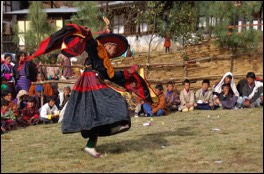
Black Hat Dance at
the Tang Festival
the Tang Festival
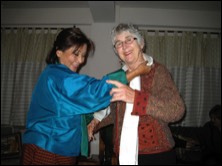
Phyllis with Bhutanese Host